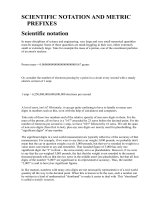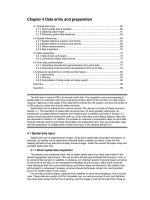Dbms chapter 4 query processing and optimization
Bạn đang xem bản rút gọn của tài liệu. Xem và tải ngay bản đầy đủ của tài liệu tại đây (2.88 MB, 140 trang )
Ho Chi Minh City University of Technology
Faculty of Computer Science and Engineering
Chapter 4: Algorithms for Query
Processing and Optimization
Database Management Systems
(CO3021)
Computer Science Program
Dr. Võ Thị Ngọc Châu
()
Semester 1 – 2020-2021
Course outline
Chapter 1. Overall Introduction to Database
Management Systems
Chapter 2. Disk Storage and Basic File Structures
Chapter 3. Indexing Structures for Files
Chapter 4. Query Processing and
Optimization
Chapter 5. Introduction to Transaction Processing
Concepts and Theory
Chapter 6. Concurrency Control Techniques
Chapter 7. Database Recovery Techniques
2
References
[1] R. Elmasri, S. R. Navathe, Fundamentals of Database
Systems- 6th Edition, Pearson- Addison Wesley, 2011.
R. Elmasri, S. R. Navathe, Fundamentals of Database Systems- 7th
Edition, Pearson, 2016.
[2] H. G. Molina, J. D. Ullman, J. Widom, Database System
Implementation, Prentice-Hall, 2000.
[3] H. G. Molina, J. D. Ullman, J. Widom, Database Systems:
The Complete Book, Prentice-Hall, 2002
[4] A. Silberschatz, H. F. Korth, S. Sudarshan, Database
System Concepts –3rd Edition, McGraw-Hill, 1999.
[Internet] …
3
Content
4.1. Introduction to Query Processing
4.2. Translating SQL Queries into Relational Algebra
4.3. Algorithms for External Sorting
4.4. Algorithms for SELECT and JOIN Operations
4.5. Algorithms for PROJECT and SET Operations
4.6. Implementing Aggregate Operations and Outer
Joins
4.7. Combining Operations using Pipelining
4.8. Using Heuristics in Query Optimization
4.9. Using Selectivity and Cost Estimates in Query
Optimization
4.10. Overview of Query Optimization in Oracle
4.11. Semantic Query Optimization
4
4.1. Introduction to Query Processing
CREATE TABLE EMPLOYEE (
Fname VARCHAR(15) NOT NULL,
Minit CHAR,
Lname VARCHAR(15) NOT NULL,
Ssn CHAR(9) NOT NULL,
Bdate DATE,
Address VARCHAR(30),
Sex CHAR,
Salary DECIMAL(10,2),
Super_ssn CHAR(9),
Dno INT NOT NULL DEFAULT 1,
PRIMARY KEY (Ssn),
CONSTRAINT EMPSUPERFK
FOREIGN KEY (Super_ssn) REFERENCES
EMPLOYEE(Ssn)
ON DELETE SET NULL ON UPDATE CASCADE,
CONSTRAINT EMPDEPTFK
FOREIGN KEY(Dno) REFERENCES
DEPARTMENT(Dnumber)
ON DELETE SET DEFAULT ON UPDATE
CASCADE);
5
4.1 Introduction to Query Processing
SELECT SSN, LNAME, DNO
FROM EMPLOYEE
WHERE DNO = 1 OR
(BDATE > '01/01/1955'
AND SALARY > 30000);
Retrieve SSN, last name, and
SSN
LNAME
DNO
333445555
Wong
5
employees who work in
666884444
Narayan
5
department 1 or were born after
888665555
Borg
1
department number of all the
???
01/01/1955 with salary higher
How would you do for such results?
than 30000.
How would you want to do that?
6
SELECT SSN, LNAME, DNO
FROM EMPLOYEE
WHERE DNO = 1 OR
(BDATE > '01/01/1955'
AND SALARY > 30000);
Typical steps when
processing a high-level query
Figure 18.1, [1], pp. 656
7
4.1. Introduction to Query Processing
A query is expressed in a high-level query
language such as SQL.
scanned, parsed, validated
The scanner identifies the query tokens
(SQL keywords, attribute names, and relation
names) that appear in the query text.
The parser checks the query syntax to
determine whether it is formulated according
to the syntax grammar rules of the language.
The validator checks if all attribute and
relation names are valid and semantically
meaningful names in the database schema.
8
4.1. Introduction to Query Processing
The query is represented in an intermediate form, i.e.
internal representation.
Query Tree
Query Graph
The DBMS must then devise an execution strategy
or query plan for retrieving the results of the query
from the database files.
An execution plan includes details about the access
methods available for each relation and the algorithms to be
used in computing the relational operators represented in the
tree.
A query has many possible execution plans, and the process
of choosing a suitable one for processing a query is query
optimization.
9
4.1. Introduction to Query Processing
The query optimizer module has the task
of producing a good execution plan.
the code generator generates the code to
execute that plan.
The runtime database processor has the
task of running (executing) the query code,
whether in compiled or interpreted mode, to
produce the query result.
If a runtime error results, an error message is
generated by the runtime database processor.
10
4.1. Introduction to Query Processing
Query Tree
A tree data structure corresponds to an
extended relational algebra expression.
It represents the input relations of the query as
leaf nodes of the tree.
It represents the relational algebra operations as
internal nodes.
An execution of the query tree consists of
executing an internal node operation whenever
its operands are available and then replacing that
internal node by the relation that results from
executing the operation.
The order of execution of operations starts at the
leaf nodes and ends at the root node.
11
4.1. Introduction to Query Processing
Query Graph
Relations in the query are represented by
relation nodes, which are displayed as single
circles.
Constant values, typically from the query
selection conditions, are represented by
constant nodes, which are displayed as double
circles or ovals.
Selection and join conditions are represented by
the graph edges.
The attributes to be retrieved from each relation
are displayed in square brackets above each
relation.
12
4.1. Introduction to Query Processing
SSN, LNAME, DNO
SELECT SSN, LNAME, DNO
FROM EMPLOYEE
DNO = 1
WHERE DNO = 1 OR
OR (BDATE > '01/01/1955' AND SALARY > 30000)
(BDATE > '01/01/1955'
EMPLOYEE
Query Tree
AND SALARY > 30000);
1
DNO=1
[SSN, LNAME, DNO]
EMPLOYEE
BDATE>'01/01/1955'
'01/01/1955'
Query Graph
SALARY>30000
30000
13
4.2. Translating SQL Queries into
Relational Algebra
An SQL query is first translated into an
equivalent extended relational algebra
expression—represented as a query tree
data structure—that is then optimized.
SQL clause
Relational operation
Meaning
FROM a single table
(none)
Input table
FROM table1, table2
table1 X table2
Cartesian product
FROM table1 JOIN table2
ON conditions
table1 conditions table2
Theta join
WHERE conditions
conditions
Selection
SELECT an attribute list
an attribute list
Projection
SELECT a function list
…
[GROUP BY a grouping
attribute list]
<a grouping attribute list> ℑ
<function list>
Aggregation
14
4.2. Translating SQL Queries into
Relational Algebra
Query block: the basic unit that can be
translated into the algebraic operators and
optimized.
A query block contains a single SELECT-FROMWHERE expression, as well as GROUP BY and
HAVING clauses if these are part of the block.
Nested queries within a query are identified
as separate query blocks.
Aggregate operators (MAX, MIN, COUNT, SUM)
must be included in the extended algebra.
15
4.2. Translating SQL Queries into
Relational Algebra
Retrieve the names of employees (from any department in
the company) who earn a salary that is greater than the
highest salary in department 5
16
4.2. Translating SQL Queries into
Relational Algebra
LNAME, FNAME
MAX SALARY C
SALARY > C
DNO = 5
EMPLOYEE
EMPLOYEE
Query Tree17
4.3. Algorithms for External Sorting
Sorting is one of the primary algorithms used
in query processing.
the ORDER BY clause
sort-merge algorithms for JOIN and set operations
duplicate elimination algorithms for the PROJECT
operation
DISTINCT in the SELECT clause
External sorting : refers to sorting
algorithms that are suitable for large files of
records stored on disk that do not fit entirely
in main memory.
18
4.3. Algorithms for External Sorting
Sort-Merge strategy : starts by sorting small
subfiles (runs) of the main file and then merges
the sorted runs, creating larger sorted subfiles
that are merged in turn.
– Sorting phase: nR = b/nB
– Merging phase: dM = min(nB-1, nR)
nP = logdM(nR)
b: number of file blocks
nB: available buffer space
nR: number of initial runs
dM: degree of merging
nP: number of passes
19
4.3. Algorithms for External Sorting
set i 1; j b; /* size of the file in blocks */
k nB;
/* size of buffer in blocks */
m j/k;
/* the number of runs */
/*Sort phase*/
while (i<= m) do
{
read next k blocks of the file into the buffer or if
there are less than k blocks remaining, then read
in the remaining blocks;
sort the records in the buffer and write as a
temporary subfile;
i i+1;
}
The number of block accesses for the sort phase = 2*b
20
/*Merge phase: merge subfiles until only one remains */
set i 1;
p logk-1m;/*p: number of passes in the merging phase*/
j m;
/* the number of runs */
while (i<= p) do
{
n 1;
q j/(k-1); /*the number of runs to write in this pass*/
while ( n <= q) do
{
read next k-1 subfiles or remaining subfiles (from
previous pass) one block at a time
merge and write as new subfile one block at a time;
n n+1;
}
j q;
i i+1;
}
The number of block accesses for the merge phase = 2*(b* logdMnR)
Total cost of external sorting = 2 * b + 2 * (b * (logdMnR)) block accesses
21
4.3. Algorithms for External Sorting
g 24
a 19
d 31
c 33
b 14
e 16
r 16
d 21
m3
p 2
d 7
a 14
a 19
d 31
g 24
b 14
c 33
e 16
d 21
m 3
r 16
a 14
d 7
p 2
Sort: runs
Buffer-size = 3,
a
b
c
d
e
g
19
14
33
31
16
24
a 14
d 7
d 21
m3
p 2
r 16
Merge: pass-1
1 record/block
a 14
a 19
b 14
c 33
d 7
d 21
d 31
e 16
g 24
m3
p 2
r 16
Merge: pass-2
The first field is
a sorting field.
22
4.4. Algorithms for SELECT and
JOIN Operations
CREATE TABLE EMPLOYEE (
Fname VARCHAR(15) NOT NULL,
Lname VARCHAR(15) NOT NULL,
Ssn CHAR(9) NOT NULL,
Bdate DATE,
Sex CHAR,
Salary DECIMAL(10,2), …
Dno INT NOT NULL DEFAULT 1,
PRIMARY KEY (Ssn),
CONSTRAINT EMPSUPERFK
…
CONSTRAINT EMPDEPTFK
FOREIGN KEY(Dno) REFERENCES
DEPARTMENT(Dnumber)
ON DELETE SET DEFAULT ON UPDATE
CASCADE);
CREATE TABLE DEPARTMENT (
Dname VARCHAR(15) NOT NULL,
Dnumber INT NOT NULL,
Mgr_ssn CHAR(9) NOT NULL,
Mgr_start_date DATE,
PRIMARY KEY (Dnumber),
UNIQUE (Dname),
FOREIGN KEY (Mgr_ssn) REFERENCES EMPLOYEE(Ssn) );
CREATE TABLE WORKS_ON (
Essn CHAR(9) NOT NULL,
Pno INT NOT NULL,
Hours DECIMAL(3,1) NOT NULL,
PRIMARY KEY (Essn, Pno),
FOREIGN KEY (Essn) REFERENCES EMPLOYEE(Ssn),
FOREIGN KEY (Pno) REFERENCES PROJECT(Pnumber) );
23
4.4. Algorithms for SELECT and
JOIN Operations
Given the tables, some examples for selection:
OP1: σSSN='123456789'(EMPLOYEE)
SELECT *
OP2: σDNUMBER>5(DEPARTMENT)
FROM TABLE
WHERE CONDITIONs;
OP3: σDNO=5(EMPLOYEE)
OP4: σDNO=5 AND SALARY>30000 AND SEX='F' (EMPLOYEE)
OP4‘: σDno=5 OR Salary > 30000 OR Sex ='F' (EMPLOYEE)
OP5: σESSN='123456789' AND PNO=10(WORKS_ON)
OP6: σDNO IN (3, 27, 49)(EMPLOYEE)
OP7: σ((Salary*Commission_pct) + Salary ) > 5000(EMPLOYEE)
24
4.4. Algorithms for SELECT and
JOIN Operations
Implementing the SELECT Operation: Search
S1. Linear search (brute force): Retrieve every
record in the file, and test whether its attribute
values satisfy the selection condition.
S2. Binary search: If the selection condition
involves an equality comparison on a key
attribute on which the file is ordered, binary
search (which is more efficient than linear
search) can be used.
S3. Using a primary index or hash key to
retrieve a single record: If the selection condition
involves an equality comparison on a key
attribute with a primary index (or a hash key),
use the primary index (or the hash key) to
retrieve the record.
25









